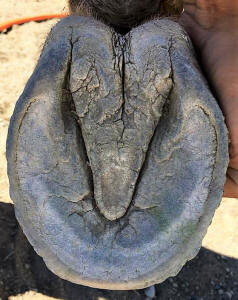
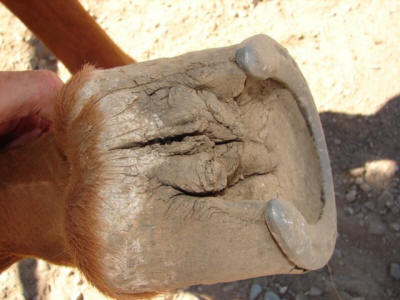
Thrush: Much More than a Cosmetic Flaw
Horseback Magazine
12-10-13
Pete Ramey
Thrush is a
common catch-all phrase for the wide assortment of bacterial and fungal
infections of the horse's frog. It is most-commonly recognized by an extra-foul
smell when picking out the hooves, by a disintegration of the frog tissue, and
sometimes by a grey or black residue in and around the frog that has a texture
resembling wet or dry, gray or white cottage cheese.
While most horse owners were taught to look out for thrush,
most tend to think of it only as a hygiene problem or merely a cosmetic flaw.
Instead, it is a serious and quite common cause of lameness, often misdiagnosed
as navicular syndrome, plus it can cause a cascade of problems within the foot,
and throughout the horse's entire body.
How critical is a
healthy frog?
When a horse is moving correctly, the foot should impact
the ground slightly heel-first. So, on rocky terrain (or any other terrain the
foot can sink into) the frog is bearing much of the initial impact force. The
frog, along with the overall flexible structure of the back-half of the foot, is
designed to dissipate much of the initial impact energy, as do the tires on your
truck. This is healthy and natural - the way the horse was built. If there is any
sensitivity in the back of the foot, the horse will avoid moving in this natural
way; instead, it will shift more impact force to the front of the foot. While
toe-first impacts are perfectly natural if a horse is travelling uphill,
accelerating, or negotiating slippery terrain, the
system was not designed to operate
this way all the time - this compensative movement robs the horse of its natural
front-line energy dissipation system, increasing the force that must be absorbed
by joints, ligaments, tendons, muscles, etc. This
can lead to injury and/or speed up long-term breakdown. Additionally, excessive
toe-first impacts can cause wall flares, hoof capsule rotation, wall cracks,
thin soles, bruises, P3 remodeling, solar corium damage and abscessing.
In short, healthy frogs are important! If you have ever
picked out a horse's foot and found yourself needing to be careful not to cause
pain with the hoof pick, think of how difficult it would be for the horse to
use the back of that foot. If the frog is healthy, it should be almost
impossible to cause pain to the bottom of a horse's foot with a typical hoof
pick, and the central cleft should not be deep or particularly sensitive.


Wet vs. Dry
Conditions
Most people tend to think of thrush as a wet-environment
issue. While it may be more common in wet conditions, it seems to
cause more pain when it occurs in the
desert. A hard, dry frog with a deeply-infected central sulcus is far more
painful than a soft, wet frog with the same infection, so no matter where you
live, you need to be on a constant lookout for this problem. That said, one of
the best things you can do to treat and prevent thrush is to keep the horse's
environment clean. It is also important to drain wet areas - you can't control how
often it rains, but you can control how long the horse's footing stays wet after
it rains. Adding gutters and drainage to the barn, adding gravel to low, wet,
high-traffic areas, cleanup of manure and urine, and general drying out of the
horse's area reaps major benefits.
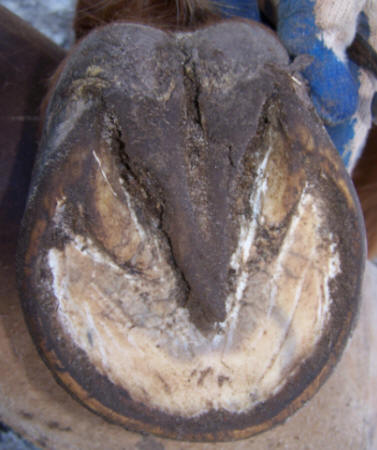
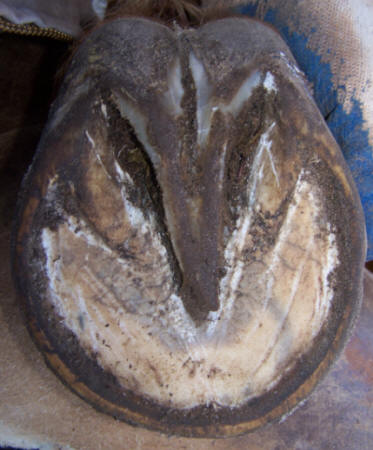
When
trimming the frog for hygiene, remove thin "flaps" along the collateral and
central sulci (grooves) that trap debris and block air flow into the crevices.
Equally important, are the ground-surface areas you should often avoid trimming.
When possible, leave these areas alone to continue callusing. It is actually
quicker and easier to trim the entire frog into a neat, tidy appearance, but in
many cases this can cause lameness. It is better to trim what you must, and
leave what you can - prioritizing soundness over beauty. Photos reprinted from the
book Care and Rehabilitation of the Equine Foot.
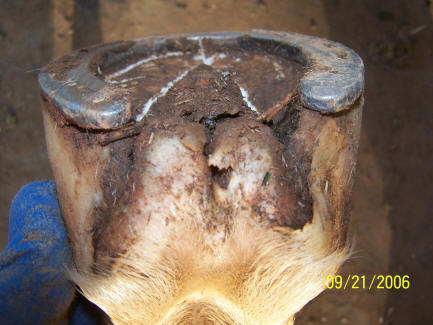
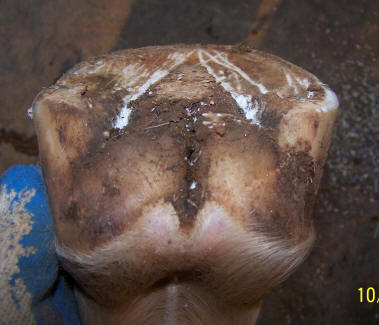
Left photo, this horse was very
lame, gingerly walking with a pronounced toe-first impact - the only real problem
I found was the thrush in the central sulcus. The heels had contracted until an
exaggerated crevice allowed infection to take over. Then the runaway infection
ate its way all the way up into the hairline. The same foot (right photo) is
shown after 4 weeks of riding in padded hoof boots and treating as described
here. The heels opened up and the lameness disappeared as the frog became more
healthy. Note that there is still an area at the central sulcus that is too
narrow and deep to see to the bottom of. Treatment needs to continue until the
entire frog is visible. Photos reprinted from the book Care and
Rehabilitation of the Equine Foot.
Trimming
When trimming the frog, try to remove tiny flaps of skin
that can harbor fungus and bacteria, but avoid over-trimming the frog and
causing sensitivity. This tightrope walk
is impossible to teach in a magazine article, but at least be aware that it is
common for horses to develop painful thrush simply because of a lack of hygienic
frog trimming - but it is equally common for horses to be lame or impact toe-first
because of excessive frog trimming.
Nutrition
As with every other problem a horse might have, there is a
critical nutritional component. I'll be brief, because I seem to discuss it in
every article, but don't underestimate its importance. When any component is
missing from the diet, the horse tends to provide what it can to the critical
organs. The skin gets the leftovers. So any gap in the nutrition profile can
weaken the frogs (and every other part of the horse's foot, along with the skin
and coat). High-quality, well-balanced nutritional supplements are typically the
best treatment (and prevention) of advanced thrush cases (I prefer California
Trace Plus).
Additionally, excess sugars in the diet can weaken the frog
tissue, as can any disease and even emotional stress. You have to consider the
whole animal, and every aspect of its health and well-being. This will sound
fruity to some, but truer words were never spoken.
Topical Treatment
Solutions
Most people are surprised that I always mention the
medicine last. Topical treatment is important, but not as important as the
factors I previously covered (environment, trimming and nutrition). Many
commercial treatments and old home remedies will work, but many of them can
actually make the situation worse. Whatever you use, be sure it kills both fungi
and bacteria - this is the easy part. The harder part is that the product must
not harm or destroy live tissue. In advanced thrush cases, particularly at the
central sulcus (cleft), the tissue at the bottom of the crevice is thin, raw,
and very sensitive. Treating this area with a destructive or caustic product
often causes more harm than good. I half-jokingly tell clients to find the most
sensitive spot on their own body and apply any would-be thrush treatment to the
area. This would quickly tell them if the remedy is appropriate to use in a
sensitive area of their horse.
How to Treat
Whatever medicine you choose, it is important to treat all the way to the deepest point of the central and collateral sulci, and any other deep pockets or splits in the frog. I have only found two ways to do this effectively. First, and probably most effective, are long soaks (at least 20 minutes) in a liquid solution. This is best-done with commercial soaking boots, but homemade models can be fashioned with inner tubes or thick plastic bags. Don't try it with a bucket. It is doubtful you will be able to soak long enough or often enough to do any good. Be sure the soaking solution kills fungus and bacteria and more importantly, be sure it does not damage or excessively dry out the young, tender live tissue attemoting to grow in to fill the lesions. My preferred soaking solutions are, 1) 50/50 apple cider vinegar/water (30-45 minutes), or 2) activated Oxine AH (4 ounces of Oxine AH, activated with either 4 ounces of white vinegar or one teaspoon of citric acid, diluted with one gallon of water, 20 minute soak in a sealed plastic bag - detailed directions here). I also like Clean Trax and White Lightning, though their price often prevents people from soaking often enough.
The other method I use is to inject a creamy or salve-type
solution deep into any crevices with a catheter-tipped syringe (Monoject 412) or
similar long-tipped tube or applicator. This requires great care not to damage
the soft tissue, but is much quicker than soaking.
When to Treat
Generally speaking, contact with air keeps these harmful
pathogens in check as well as anything. So if you can readily see the bottom of
any crevices in the frog, routine hoof picking may be all you need to treat and
prevent thrush problems. If, however, you pick out the foot and find deep areas
(usually at the central sulcus. sometimes at the collateral sulci beside the
frog) that you cannot see to the bottom of, this is a
place where you need to treat. Keep treating until the area fills in and/or
opens up so you can see the entire surface.
Use those same criteria for prevention - always treat any
deep pockets as soon as they try to form in the future, and then discontinue
treatment as soon as you can see the entire frog. Treated in this proactive
fashion, it is very rare for thrush problems to develop to a point that they
cause pain for the horse, and as usual, it is far easier to prevent these
problems than it is to cure them.